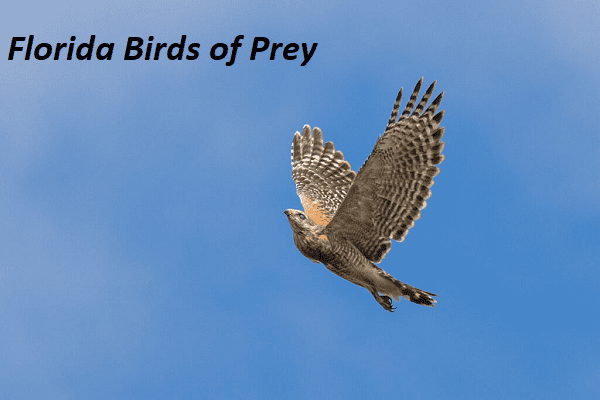Florida birds of prey, renowned for its diverse ecosystems and abundant wildlife, is home to a remarkable array of birds of prey. These raptors, distinguished by their keen eyesight, powerful talons, and formidable beaks, play a crucial role in maintaining the ecological balance by controlling populations of small mammals, birds, and insects. This comprehensive overview explores the various species of birds of prey found in Florida, their habitats, behaviors, and conservation status.
Types of Birds of Prey in Florida
Bald Eagle (Haliaeetus leucocephalus)
The Bald Eagle, America’s national bird, is a majestic symbol of strength and freedom. Florida hosts one of the largest populations of Bald Eagles in the contiguous United States, with more than 1,500 nesting pairs.
Habitat and Behavior
Bald Eagles thrive in coastal areas, rivers, large lakes, and marshes where they have ample access to fish, their primary diet. They build enormous nests, known as eyries, in tall trees or on cliff faces, which they reuse and expand annually.
Conservation Status
Once endangered due to DDT pesticide use and habitat destruction, Bald Eagles have made a significant recovery following conservation efforts and the banning of DDT. They are currently listed as Least Concern by the IUCN but remain protected under the Bald and Golden Eagle Protection Act.
Osprey (Pandion haliaetus)
Also known as the sea hawk, the Osprey is a fish-eating bird of prey found near water bodies across Florida.
Habitat and Behavior
Ospreys are often seen soaring above lakes, rivers, and coastal areas. They are expert anglers, with reversible outer toes and barbed pads on their feet that help them grasp slippery fish. Ospreys build large stick nests near water, on platforms, utility poles, or tall trees.
Conservation Status
Ospreys have also benefited from conservation measures and are now listed as Least Concern. They serve as an indicator species for healthy fish populations.
Red-shouldered Hawk (Buteo lineatus)
The Red-shouldered Hawk is a medium-sized raptor commonly found in Florida’s forests and wetlands.
Habitat and Behavior
These hawks prefer wooded swamps, riversides, and mixed forests. They hunt small mammals, amphibians, and reptiles. Red-shouldered Hawks are known for their distinctive reddish-brown shoulders and loud, distinctive calls.
Conservation Status
Their population is stable, and they are listed as Least Concern. They are a common sight in suburban areas, adapting well to human presence.
Swallow-tailed Kite (Elanoides forficatus)
The Swallow-tailed Kite is one of the most elegant and acrobatic raptors, easily recognizable by its deeply forked tail and striking black and white plumage.
Habitat and Behavior
These kites inhabit lowland forests, swamps, and marshes. They are aerial foragers, catching insects and small vertebrates in flight. Swallow-tailed Kites are migratory, spending the winter in South America and returning to Florida in the spring to breed.
Conservation Status
While their population is currently stable, they are considered Near Threatened due to habitat loss and degradation. Conservation efforts focus on preserving their breeding and foraging habitats.
Great Horned Owl (Bubo virginianus)
Known as the “tiger of the sky,” the Great Horned Owl is a powerful and versatile predator found throughout Florida.
Habitat and Behavior
These owls occupy a wide range of habitats, including forests, swamps, deserts, and urban areas. They have a diverse diet, preying on mammals, birds, reptiles, and even other raptors. Great Horned Owls are nocturnal and are recognized by their deep hooting calls and prominent ear tufts.
Conservation Status
The Great Horned Owl population is stable, and they are listed as Least Concern. They are highly adaptable and can thrive in various environments, including cities.
Peregrine Falcon (Falco peregrinus)
The Peregrine Falcon, renowned for its incredible speed, is the fastest bird in the world, capable of diving at speeds exceeding 200 mph.
Habitat and Behavior
Peregrine Falcons are found in a variety of habitats, including coastal regions, mountains, and urban areas where they nest on tall buildings. They primarily hunt birds, capturing them mid-air with astonishing agility.
Conservation Status
Peregrine Falcons were severely impacted by DDT but have made a strong recovery thanks to conservation efforts. They are now listed as Least Concern and continue to be monitored closely.
Barred Owl (Strix varia)
The Barred Owl, with its haunting calls and soulful eyes, is a nocturnal bird of prey commonly found in Florida’s woodlands and swamps.
Habitat and Behavior
Barred Owls prefer dense forests near water. They hunt a variety of prey, including small mammals, birds, and amphibians. Their distinctive “who-cooks-for-you” call is a familiar sound in Florida’s forests.
Conservation Status
Barred Owls are listed as Least Concern and have stable populations. They are, however, facing competition and hybridization issues with the invasive Spotted Owl in some regions.
Ecological Significance
Birds of prey play a vital role in maintaining the health and balance of ecosystems. They control populations of rodents, insects, and other small animals, preventing overpopulation and the spread of diseases. Raptors also serve as bioindicators, reflecting the health of their environments. Changes in their populations can signal shifts in ecosystem health, prompting further investigation and conservation actions.
Conservation Challenges and Efforts
Despite their crucial role, birds of prey face numerous challenges, including habitat loss, climate change, pollution, and human disturbances. Urbanization and deforestation lead to the loss of nesting and foraging habitats, while pesticide use can poison raptors and reduce their prey populations.
Conservation Initiatives
Several conservation initiatives have been implemented to protect Florida’s birds of prey:
Habitat Protection
Efforts to preserve and restore natural habitats, such as wetlands and forests, are crucial for the survival of raptors. Protected areas and wildlife refuges provide safe havens for breeding and foraging.
Legislation
Laws like the Bald and Golden Eagle Protection Act and the Migratory Bird Treaty Act offer legal protection to raptors, prohibiting the killing, capturing, or trading of these birds.
Pesticide Regulation
Banning harmful pesticides like DDT has significantly contributed to the recovery of raptor populations. Continued regulation and monitoring of pesticide use are essential.
Public Awareness and Education
Educating the public about the importance of birds of prey and how to coexist with them helps reduce human-wildlife conflicts. Programs in schools, nature centers, and wildlife organizations play a vital role in conservation efforts.
Research and Monitoring
Ongoing research and monitoring of raptor populations help identify emerging threats and inform conservation strategies. Banding programs, satellite tracking, and citizen science initiatives provide valuable data on migration patterns, breeding success, and survival rates.
Success Stories
The recovery of the Bald Eagle and Peregrine Falcon are notable success stories in raptor conservation. These species have rebounded from the brink of extinction due to targeted conservation efforts, showcasing the effectiveness of collaborative conservation work.
Conclusion
Florida’s birds of prey are not only captivating to observe but also essential to the health of the state’s ecosystems. These raptors, with their remarkable adaptations and behaviors, are integral to controlling prey populations and maintaining ecological balance. Conservation efforts have yielded significant successes, but continued vigilance is necessary to ensure their protection in the face of ongoing environmental challenges. By appreciating and safeguarding these magnificent birds, we contribute to the preservation of Florida’s rich biodiversity and natural heritage.











+ There are no comments
Add yours